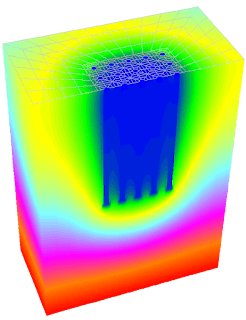The published code TCVN 10304:2014 “Pile foundation – Design standards” has overcome the fatal weaknesses that construction designers encounter and implicitly understand each other that TCXDVN 205:1998 due to spelling errors or unclear instructions. More importantly, the predicted load-bearing capacity of piles according to the new standard gives high values and is close to the actual static compression test of countless works during more than ten years of actual use of pile foundations.

Thus, the theoretical basis is clear. The task of the design engineer is now to apply the new standard in the work of predicting the bearing capacity of piles by building tools (software, Excel spreadsheets…). The following are the steps to apply TCVN 10304:2014 in the most practical way for 2 common types of piles: bored piles and driven/pressed piles.
1. Calculating the bearing capacity according to pile material
In most cases of practical structural design, the piles are subjected to the central compressive force transmitted from the foundation from the above construction, the pile material is usually reinforced concrete. Use the calculation formula as the concrete member subjected to central compression of TCVN 5574:2012 as follows:
$$P_{VL}=\varphi\left(R_bA_b+R_{sc}A_{st}\right)$$
Formula explanation:
$A_{st}$ is the total longitudinal reinforcement area in the pile
$A_b$ is the concrete area in the same pile cross-section
$R_{sc}$ is the calculated compressive strength of the reinforcement
$R_b$ is the calculated compressive strength of the pile concrete, equal to the original calculated strength of the concrete multiplied by the working condition coefficients $\gamma_{cb}.\gamma’_{cb}$ as follows:
$\gamma_{cb}$=0.85 including concrete pouring in the narrow space of the borehole, casing
- for $\lambda\leqslant28,\varphi=1$
- for $28<\lambda\leqslant120, \varphi=1,028-0,0000288{\lambda}^2-0,0016\lambda$
When calculating structural design based on material strength, consider the pile as a rigid rod embedded in the ground at a depth of: $l_1=l_o+\frac{2}{\alpha_{\varepsilon}}$
$l_o$ is the length of the pile from the bottom of the foundation to the ground level
$$\alpha_{varepsilon}=5\sqrt{\frac{kb_p}{\gamma_cEI}}$$
In case of designing pile structures using prestressed reinforced concrete, the load bearing capacity according to pile material is calculated according to the instructions of TCVN 7888:2008.
2. Calculate pile load bearing capacity according to Soil
The load bearing capacity of piles according to ground is determined for compressed piles as follows:
$$Q_a=\frac{\gamma_o}{\gamma_n}\frac{R_{c,u}}{\gamma_k}-W_c$$
$R_{c,u}$ is the ultimate compressive load bearing capacity
$W_c$ is the self-weight of the pile including the reliability factor of 1.1
$\gamma_o$ is the working condition factor, taking into account the factor of increasing the uniformity of the ground when using pile foundations, taken as 1 for single piles and taken as 1.15 for multi-pile foundations
$\gamma_n$ is the reliability factor of the importance of the project, taken as 1.2; 1.15 and 1.1 corresponding to the importance of level I, II and III projects (Appendix F of the standard)
$\gamma_k$ is the reliability factor according to the soil determined according to Article 7.1.11 of the standard
In current Structural Engineering practice, it is common to calculate the pile bearing capacity based on the results of standard penetration tests (SPT) using the two Meyerhof formulas and the formula of the Japan Institute of Architecture as follows:
Meyerhof formula:
Ultimate compressive load capacity:
$q_b$ is the soil strength under the pile tip $q_b=k_1N_p$
$k_1$ is the coefficient, $k_1=40h/d\leqslant400$ for driven/pressed piles and k1=120 for bored piles
h is the pile depth
$N_p$ is the average SPT index in the range of 1d below the pile tip and 4d above the pile tip
$f_i$ is the soil strength along the pile body
- in loose soil layers $f_i=k_2N_{s,i}$
- in cohesive soil layers $f_i={\alpha}c_{u,i}$
k2 is the coefficient taken as 2.0 for driven/jacking piles and as 1.0 for bored piles
α is the coefficient determined according to the diagram in Figure G.2 of the standard
$N_{s,i}$ is the average SPT index of the i-th soil layer on the pile body
$c_{u,i}$ is the undrained shear strength of the i-th soil layer on the pile body $c_{u,i}=6,25N_{c,i}(kPa)$
$N_{c,i}$ is the SPT index in the cohesive soil of the i-th soil layer on the pile body.
Formula of the Architectural Institute of Japan:
$$R_{c,u}=q_bA_b+u\sum{\left(f_{c,i}l_{c,i}+f_{s,i}l_{s,i}\right)}$$
- When the pile tip is in the loose soil layer $q_b=300N_p$ for driven/jacking piles and $q_b=150N_p$ for bored piles
- When the pile tip is in the cohesive soil layer $q_b=9c_u$ for driven/jacking piles and $q_b=6c_u$ for bored piles

$l_{s,i}$ is the length of the pile segment in the i-th loose soil layer
$l_{c,i}$ is the length of the pile segment in the i-th cohesive soil layer
$N_p$ For sandy soils, if the value $N_p>50$, then only take $N_p=50$, if the value $N_{s,i}>50$, then take $N_{s,i}=50$
For compacted rock or gravel foundations, when $N_p>100$, take $q_b=20$MPa for driven/pressed piles and bored piles with reliable pile tip cleaning measures and cement mortar injection to reinforce the soil under the pile tip.
Normally, for foundations with many layers of cohesive soil along the pile body, the value of the soil bearing capacity calculated by the Japanese formula is often greater than the Meyerhof formula. the Structural Engineer should choose the value as the predicted bearing capacity according to one of the two formulas above, from which they will decide on the maximum static compression test load value as the basis for adjusting the mass piles later.
3. Check the load-bearing capacity of the pile
4. Conclusion

